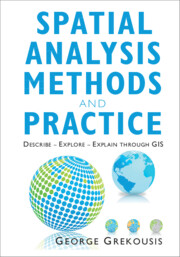Book contents
- Spatial Analysis Methods and Practice
- Reviews
- Spatial Analysis Methods and Practice
- Copyright page
- Contents
- Preface
- 1 Think Spatially
- 2 Exploratory Spatial Data Analysis Tools and Statistics
- 3 Analyzing Geographic Distributions and Point Patterns
- 4 Spatial Autocorrelation
- 5 Multivariate Data in Geography
- 6 Modeling Relationships
- 7 Spatial Econometrics
- References
- Index
4 - Spatial Autocorrelation
Published online by Cambridge University Press: 20 May 2020
- Spatial Analysis Methods and Practice
- Reviews
- Spatial Analysis Methods and Practice
- Copyright page
- Contents
- Preface
- 1 Think Spatially
- 2 Exploratory Spatial Data Analysis Tools and Statistics
- 3 Analyzing Geographic Distributions and Point Patterns
- 4 Spatial Autocorrelation
- 5 Multivariate Data in Geography
- 6 Modeling Relationships
- 7 Spatial Econometrics
- References
- Index
Summary
This chapter deals with
Spatial autocorrelation and its importance to geographical problems
Global and local spatial autocorrelation techniques like Moran’s I, Getis-Ord G and Geary C
Tracing spatial clusters of high values (hot spots) or low values (cold spots)
Tracing spatial outliers
Optimized hot spot analysis
Interpreting the statistical significance of results
Incremental spatial autocorrelation used to define the appropriate scale of analysis
The multiple comparison problem and spatial dependence
Introducing Bonferroni correction and the false discovery rate
Spatiotemporal autocorrelation analysis using bivariate and differential Local Moran’s I index
Presenting examples of step-by-step solutions using ArcGIS and GeoDa
After a thorough study of the theory and lab sections, you will be able to
Distinguish between global and local spatial autocorrelation
Understand why spatial autocorrelation analysis is relevant to geographical analysis
Apply local and global indices of spatial autocorrelation like local Moran’s, Getis-Ord Gi and Gi∗
Use Moran’s I scatter plot to identify patterns
Identify if clustering of hot or cold spots exist
Identify and locate spatial outliers
Use Bivariate and Differential Local Moran’s I to identify if spatiotemporal autocorrelation exists and if changes cluster over time
Apply these tools using ArcGISand GeoDa
Interpret the results from both the statistical significance and spatial analysis standpoints
Keywords
- Type
- Chapter
- Information
- Spatial Analysis Methods and PracticeDescribe – Explore – Explain through GIS, pp. 207 - 274Publisher: Cambridge University PressPrint publication year: 2020
- 4
- Cited by



